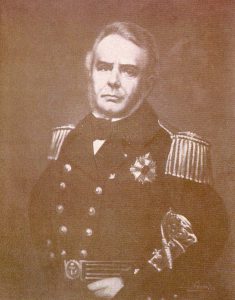Admiral John Pascoe Grenfell (1800 - 1869) Brazilian Navy
 GRENFELL, JOHN PASCOE (1800-1869), Admiral in the Brazilian navy, born at Battersea on 20 Sept 1800,was a son of J. G. Grenfell and nephew of Pascoe Grenfell [q. v.]. When eleven years old he entered the service of the East India Company; but after having made several voyages to India, in 1819 he joined the service of the Chilean republic under Lord Cochrane [see COCHRANE, THOMAS, tenth EARL, of DUNDONALD], was made a lieutenant, and took part in most of Cochrane’s exploits in the war of Chilean independence, and notably in the cutting out of the Esmeralda, when he was severely wounded.
GRENFELL, JOHN PASCOE (1800-1869), Admiral in the Brazilian navy, born at Battersea on 20 Sept 1800,was a son of J. G. Grenfell and nephew of Pascoe Grenfell [q. v.]. When eleven years old he entered the service of the East India Company; but after having made several voyages to India, in 1819 he joined the service of the Chilean republic under Lord Cochrane [see COCHRANE, THOMAS, tenth EARL, of DUNDONALD], was made a lieutenant, and took part in most of Cochrane’s exploits in the war of Chilean independence, and notably in the cutting out of the Esmeralda, when he was severely wounded.
In 1823 he accompanied Cochrane to Brazil, with the rank of commander, and served under his orders in the war with Portugal, specially distinguishing himself in the reduction of Para.
Afterwards, under Commodore Norton, in the action of Buenos Ayres on 29 July 1826, he lost his right arm. He then went to England for the re-establishment of his health, but returned to Brazil in 1828. In 1835-6 he commanded the squadron on the lakes of the province of Rio Grande do Sul against the rebel flotillas, which he captured or destroyed, thus compelling the rebel army to surrender.
In 1841 he was promoted to be rear-admiral. In 1846 he was appointed consul-general in England, to reside in Liverpool, and in August 1848, while superintending the trial of the Alfonzo, a ship of war built at Liverpool for the Brazilian government, assisted in saving the lives of the passengers and crew of the emigrant ship Ocean Monarch, burnt off the mouth of the Mersey. For his exertions at this time he received the thanks of the corporation and the gold medal of the Liverpool Shipwreck Society. In 1851, on way breaking out between Brazil and the Argentine republic, he returned to take command of the Brazilian navy, and in December, after a sharp conflict, forced the passage of the Parana. After the peace he was promoted to be vice-admiral, and later on to be admiral; but in 1852 he returned to Liverpool, and resumed his functions as consul-general, holding the office until his death on 20 March 1869. He is buried in the Pere Lachaise Cemetery, Paris, France.
He married, at Monte Video in 1829, Dona Maria Dolores Masini, and left issue; among others, Harry Tremenheere Grenfell, a captain in the royal navy, who on l3 Feb.1882, while shooting in the neighbourhood of Artaki, in the Sea of Marmora, was severely wounded in a chance affray with some native shepherds; he narrowly escaped with his life, his companion, Commander Selby, being killed. An elder son, John Granville Grenfell, commissioner of crown lands in New South Wales, was killed while defending the mail against an attack of bushrangers on 7 Dec. 1866 (Sydney Morning Herald, 11, 21 Dec. 1866).
[Times, 22 March 1869; Illustrated London .News, 4 Dec. 1852; Mulhall’s English in South America, p. 210; Armitage’s Hist. of Brazil; information from the family.] J. K. L.
Text reproduced from the Dictionary of National Biography, Earliest Times to 1900 Vol. V111, edited by Sir Leslie Stephen and Sir Sidney Lee, by permission of Oxford University Press.

